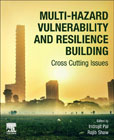
Multi-Hazard Vulnerability and Resilience Building: Cross Cutting Issues
Pal, Indrajit
Shaw, Rajib
Multi-hazard Vulnerability and Resilience Building: Cross Cutting Issues presents multi-disciplinary issues facing disaster risk reduction and sustainable development, focusing on various dimensions of existing and future risk scenarios and highlighting concerted efforts of scientific communities to find new adaptation methods. Disaster risk reduction and resilience requires participation of a wide array of stakeholders, ranging from academicians to policy makers to disaster managers. The book offers evidence-based, problem-solving techniques from social, natural, engineering, and other perspectives, and connects data, research, and conceptual work with practical cases on disaster risk management to capture multi-sectoral aspects of disaster resilience, adaptation strategy, and sustainability. Provides foundational knowledge on integrated disaster vulnerability and resilience building Brings together disaster risk reduction and resilience scientists, policy-makers, and practitioners from different disciplines Includes case studies on disaster resilience and sustainable development from a multi-disciplinary perspective INDICE: Section 1: Introduction and Overview 1. Overview of multi - hazard Vulnerability and Resilience Section 2: Technology and Innovation 2. Opportunities for implementing multi-hazard impact-based forecast and warning system to achieve Sendai Framework for DRR: a case from Bangladesh 3. Seismic Fragility of Load Bearing Soft Brick Unreinforced Masonry Piers 4. GIS based HVRA for Risk Anticipation and Disaster Risk Reduction 5. Vulnerability mapping of residential buildings with respect to cyclonic wind in Mauritius using Remote Sensing and QGIS 6. Mechanical Behavior of Geopolymer in Addition with Fibre Reinforced Materials - A Review Section 3: Risk Assessment and Analysis 7. Time-Frequency Analysis of Strong Ground Motions from the Mw 6.8 1991 Uttarkashi Earthquake 8. Time-Frequency Analysis of Ground Motions from the 1999 Chamoli Earthquake 9. Efficient earthquake intensity measures for probabilistic seismic demand models of skewed bridges 10. Multi-hazard impact and vulnerability analysis in building city infrastructure resilience 11. Evaluate the durability of RC Bridge under the impact of Climate change in Vietnam 12. Predict the critical load of rectangular concrete-filled steel tube columns with ultra-high-strength concrete with software ANSYS 13. Wavelet analysis of Near-Field Ground Motions from the Mw 7.8 2015 Gorkha Earthquake Section 4: Community Adaptation and Resilience 14. A Framework of Risk Profile in Public Healthcare System Development: A Literature Review 15. Indigenous Knowledge in Disaster Management: An ethnographic study of Chepang community 16. Community Perception of Flood Induced Health Risk in Sudan, a case study of Sharq El-Nile area 17. Reframing the disaster risk discourse to incorporate indigenous knowledge 18. A Risk Based Approach of Assessing Cyclone Shelter Locational Needs in the Coastal Region of Bangladesh 19. Opportunities and Challenges Farmer's Experiences using indigenous Knowledge to adapt to climate change in sustainable development in Mekong Delta, Vietnam 20. Pesticide Use Pattern & Health Impacts Among Farmers & Labourers in Kalahandi District of Odisha, India 21. A common framework for MOOC curricular development in climate change education - findings and adaptations under the BECK project for higher education institutions in Europe and Asia Section 5: Governance and Sustainability 22. Disaster Management Practices Amidst COVID-19 Pandemic: Emergency Response of Merapi Volcano Eruption 23. Sustainability Assessment of Residential Building in Urban Area - A case study 24. WASH Systems in Developing Nations: An Evaluation Framework for Institutional Resilience 25. A proposal for disaster risk management in the local level: lesson learned from earthquake prone area in Sengon Village, Central Java, Indonesia 26. Community Resilience for Disaster Risk Reduction by Engaging local Governance in Bihar India 27. A Working Strategy for Preparedness in Kerala schools: A Suggestive Study 28. A Framework for Women's Empowerment in Disaster Risk Governance 29. Target E of Sendai Framework: Current Status and how to complete by 2022 end
- ISBN: 978-0-323-95682-6
- Editorial: Elsevier
- Encuadernacion: Rústica
- Páginas: 450
- Fecha Publicación: 20/01/2023
- Nº Volúmenes: 1
- Idioma: Inglés
